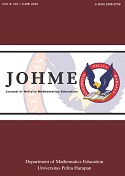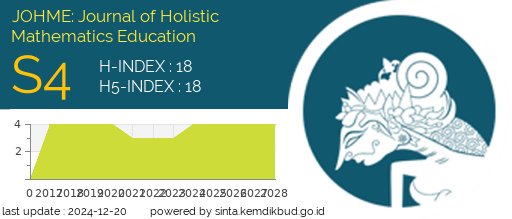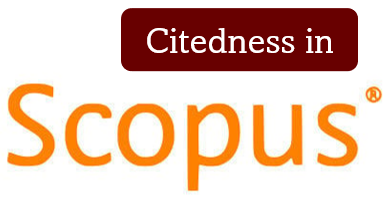KEMAMPUAN REPRESENTASI MATEMATIS SISWA SMP NU SUNAN AMPEL DALAM MENYELESAIKAN MASALAH KONTEKSTUAL GEOMETRI [MATHEMATICS REPRESENTATION ABILITY OF NU SUNAN AMPEL JUNIOR HIGH SCHOOL STUDENTS IN SOLVING GEOMETRY CONTEXTUAL PROBLEMS]
DOI:
https://doi.org/10.19166/johme.v6i1.5369Kata Kunci:
mathematics representation ability, contextual problems, geometry, kemampuan representasi matematis, masalah kontekstual, geometriAbstrak
The ability of mathematical representation is needed by students to communicate mathematical ideas. However, the student's representation ability is still not optimal, especially in geometry material. The purpose of this study is to describe the representational abilities of students of SMP NU Sunan Ampel in solving geometrical contextual problems. The study was conducted on 19 students at SMP NU Sunan Ampel Poncokusumo. Data was collected through tests and interviews. The indicators of representation ability used are visual representation, symbolic, and verbal. The results of the research are the level of student representation ability as much as 53% in the low category, as much as 42% in the medium category, and as much as 5% in the high category. Students with high representation ability can fulfill the indicators of visual, symbolic, and verbal representation well according to their abilities. Students with moderate representational abilities can meet the indicators of symbolic representation, but there are still errors in writing and calculations. Students with low representation ability have not reached the three indicators of representational ability well as a whole according to their abilities. It is hoped that the teacher can provide practice questions to students by requiring students to describe and write down the mathematical model in detail and completely. In addition, the teacher can also introduce various forms of flat shapes in contextual problems so that students can be trained to solve contextual problems related to flat shapes.
BAHASA INDONESIA ABSTRACT: Kemampuan representasi matematika sangatlah dibutuhkan oleh siswa untuk mengkomunikasikan ide matematika. Namun, kemampuan representasi siswa masih belum optimal khususnya pada materi geometri. Tujuan penelitan ini mendeksripsikan kemampuan representasi siswa SMP NU Sunan Ampel dalam menyelesaikan masalah kontekstual geometri. Penelitian dilaksanakan pada 19 siswa di SMP NU Sunan Ampel Poncokusumo. Data dikumpulkan melalui tes dan wawancara. Indikator kemampuan representasi yakni representasi visual, simbolik, dan verbal. Hasil penelitian yakni tingkat kemampuan representasi siswa sebanyak 53% pada kategori rendah, sebanyak 42% pada kategori sedang, dan sebanyak 5% pada kategori tinggi. Siswa kemampuan representasi tinggi dapat memenuhi indikator representasi visual, simbolik, dan verbal dengan baik sesuai kemampuannya. Siswa kemampuan representasi sedang dapat memenuhi indikator representasi simbolik, namun masih terdapat kesalahan penulisan dan perhitungan. Siswa kemampuan representasi rendah belum mencapai ketiga indikator kemampuan representasi dengan baik secara keseluruhan sesuai dengan kemampuannya. Harapannya guru dapat memberikan latihan soal kepada siswa dengan mewajibkan siswa menggambarkan dan menuliskan model matematikanya secara detail dan lengkap. Selain itu, guru juga dapat memperkenalkan berbagai bentuk bangun datar dalam masalah kontekstual agar siswa dapat terlatih menyelesaikan masalah kontekstual yang berkaitan dengan bangun datar.
Referensi
Amalia, A., Happy, N., & Purwosetiyono, F. X. D. (2021). Profil kemampuan representasi siswa dalam memecahkan masalah matematika ditinjau dari gaya belajar. Phenomenon: Jurnal Pendidikan MIPA, 11(1), 15-28. https://doi.org/10.21580/phen.2021.11.1.6521
Anggo, M. (2011). Pemecahan masalah matematika kontekstual untuk meningkatkan kemampuan metakognisi siswa. EDUMATICA: Jurnal Pendidikan Matematika, 1(2), 35-42. Retrieved from https://online-journal.unja.ac.id/edumatica/article/view/182/6836
Cankoy, O., & Özder, H. (2011). The influence of visual representations and context on mathematical word problem solving. Pamukkale Üniversitesi Eğitim Fakültesi Dergisi, 30, 91-100. Retrieved from http://pauegitimdergi.pau.edu.tr/Makaleler/745832325_91-100.pdf
Fitrianingrum, & Basir, M. A. (2020). Analisis kemampuan representasi matematis siswa dalam menyelesaikan soal aljabar. Vygotsky, 2(1), 1-11. https://doi.org/10.30736/vj.v2i1.177
Halat, E., & Peker, M. (2011). The impacts of mathematical representations developed through webquest and spreadsheet activities on the motivation of pre-service elementary school teachers. TOJET: The Turkish Online Journal of Educational Technology, 10(2), 259-67. Retrieved from https://files.eric.ed.gov/fulltext/EJ932244.pdf
Handayani, H., & Juanda, R. Y. (2018). Profil kemampuan representasi matematis siswa sekolah dasar di kecamatan Sumedang Utara. Primary: Jurnal Pendidikan Guru Sekolah Dasar, 7(2), 211-217. https://doi.org/10.33578/jpfkip.v7i2.6265
Handayani, U. F. (2021). Komunikasi matematis siswa dalam memecahkan masalah aljabar tarik tambang. ARITMATIKA : Jurnal Riset Pendidikan Matematika, 2(2), 67-78. https://doi.org/10.35719/aritmatika.v2i2.58
Listiani, T., Dirgantoro, K. P. S., Saragih, M. J., & Tamba, K. P. (2019). Analisis kesalahan mahasiswa pendidikan matematika dalam menyelesaikan soal geometri pada topik bangun ruang. JOHME: Journal of Holistic Mathematics Education, 3(1), 44-62. https://doi.org/10.19166/johme.v3i1.1708
Mulyaningsih, S., Marlina, R., & Effendi, K. N. S. (2020). Analisis kemampuan representasi matematis siswa SMP dalam menyelesaikan soal matematika. JKPM (Jurnal Kajian Pendidikan Matematika), 6(1), 99-110. https://doi.org/10.30998/jkpm.v6i1.7960
Polya, G. (1985). How to solve it: A new aspect of mathematical method. London, UK: Penguin Books.
Rahayu, S., & Hakim, D. L. (2021). Deskripsi kemampuan representasi matematis siswa SMP dalam menyelesaikan soal pada materi segi empat. JPMI: Jurnal Pembelajaran Matematika Inovatif, 4(5), 69-80. Retrieved from https://journal.ikipsiliwangi.ac.id/index.php/jpmi/article/view/7809/2686
Samo, D. D., Darhim, & Kartasasmita, B. (2017). Developing contextual mathematical thinking learning model to enhance higher-order thinking ability for middle school students. International Education Studies, 10(12), 17-29. https://doi.org/10.5539/ies.v10n12p17
Sari, H. J., Kusaeri, A., & Mauliddin. (2020). Analisis kemampuan representasi matematis siswa dalam memecahkan masalah geometri. JPMI: Jurnal Pendidikan Matematika Indonesia, 5(2), 56-66. Retrieved from https://journal.stkipsingkawang.ac.id/index.php/JPMI/article/view/1813/pdf
Sulastri, Marwan, & Duskri, M. (2017). Kemampuan representasi matematis siswa SMP melalui pendekatan pendidikan matematika realistik. Beta Jurnal Tadris Matematika, 10(1), 51-69. https://doi.org/10.20414/betajtm.v10i1.101
Ulya, H. (2015). Hubungan gaya kognitif dengan kemampuan pemecahan masalah matematika siswa. Jurnal Konseling Gusjigang, 1(2), 1-12. https://doi.org/10.24176/jkg.v1i2.410
Umaroh, U., & Pujiastuti, H. (2020). Analisis kemampuan representasi matematis siswa dalam mengerjakan soal PISA ditinjau dari perbedaan gender. Jurnal Pendidikan Matematika Raflesia, 5(2), 40-53. Retrieved from https://ejournal.unib.ac.id/index.php/jpmr/article/view/11408/5734
Villegas, J. L., Castro, E., & Gutiérrez, J. (2009). Representations in problem solving: A case study with optimization problems. Electronic Journal of Research in Educational Psychology, 7(17), 279-308. Retrieved from http://repositorio.ual.es/bitstream/handle/10835/713/Art_17_297_eng.pdf?sequence=1
Wahyudi, & Anugraheni, I. (2017). Strategi pemecahan masalah matematika. Salatiga, Indonesia: Satya Wacana University Press.
Yudhanegara, M. R., & Lestari, K. E. (2014). Meningkatkan kemampuan representasi beragam matematis siswa melalui pembeajaran berbasis masalah terbuka. Jurnal Ilmiah Solusi, 1(4), 97-106. Retrieved from https://journal.unsika.ac.id/index.php/solusi/article/view/60/60Unduhan
File Tambahan
Diterbitkan
Cara Mengutip
Terbitan
Bagian
Lisensi
Authors who publish with this journal agree to the following terms:
1) Authors retain copyright and grant the journal right of first publication with the work simultaneously licensed under a Creative Commons Attribution License (CC-BY-SA 4.0) that allows others to share the work with an acknowledgement of the work's authorship and initial publication in this journal.
2) Authors are able to enter into separate, additional contractual arrangements for the non-exclusive distribution of the journal's published version of the work (e.g., post it to an institutional repository or publish it in a book), with an acknowledgement of its initial publication in this journal.
3) Authors are permitted and encouraged to post their work online (e.g., in institutional repositories or on their website). The final published PDF should be used and bibliographic details that credit the publication in this journal should be included.”










